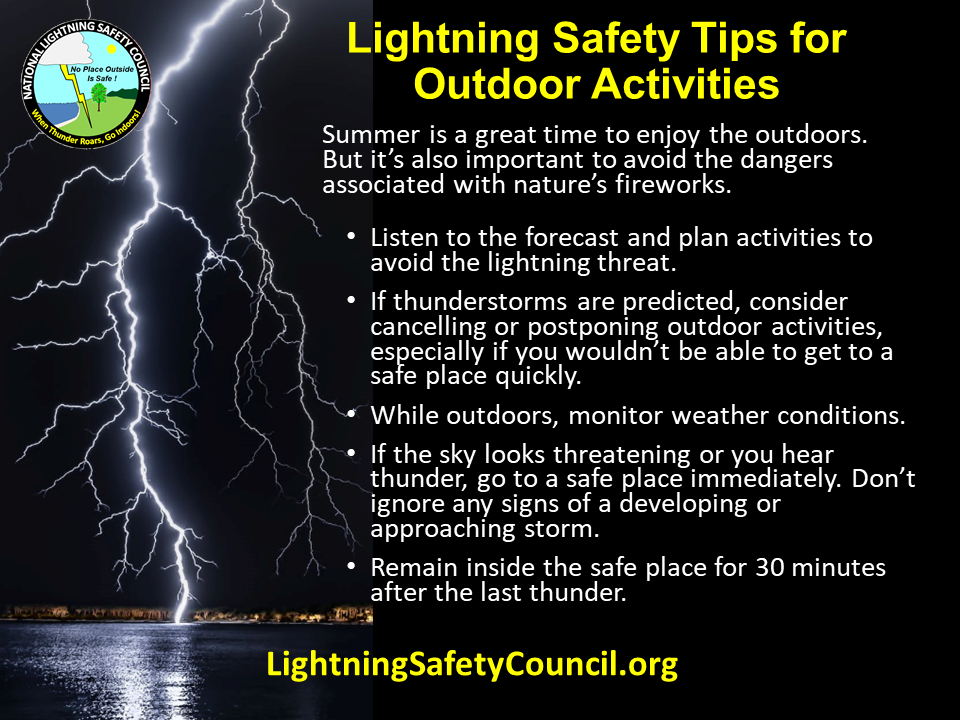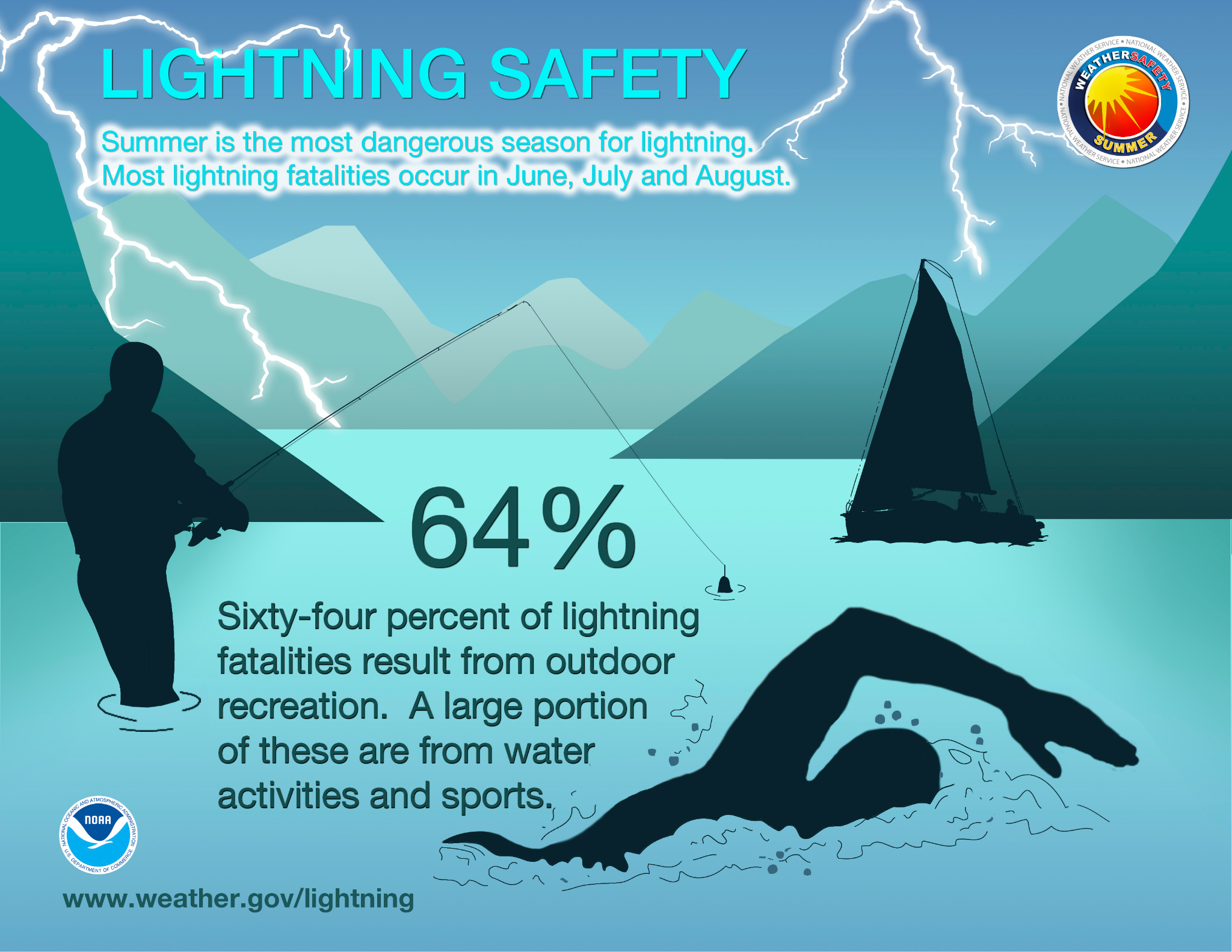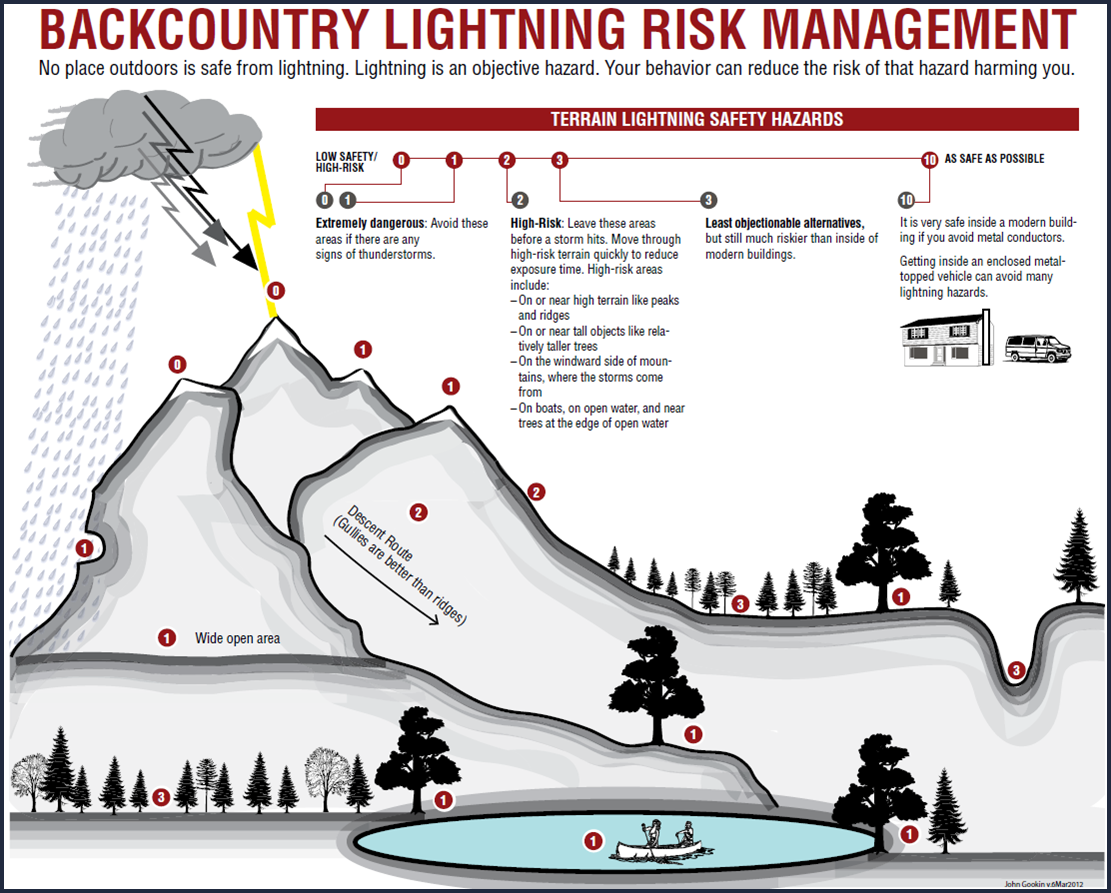Seek shelter immediately if you hear thunder or see lightning while outdoors. Avoid open fields, tall trees, and water.
Lightning poses serious risks when you’re outside. Always stay alert to weather changes. Seeking proper shelter can save lives. Safe locations include buildings with plumbing and electricity or fully enclosed metal vehicles. Avoid open spaces, tall objects, and water during a storm.
Crouching low to the ground is safer if you can’t find shelter. Leave metal objects and electronics behind to reduce risk. Understanding these safety tips can protect you and your loved ones. Plan your outdoor activities with weather forecasts in mind. Quick and informed decisions ensure safety during lightning storms.
Introduction To Lightning Safety
Lightning can be very dangerous. It strikes without warning and can cause severe harm. Understanding lightning safety is crucial for anyone who spends time outdoors. This guide will help you stay safe during thunderstorms.
Importance Of Awareness
Awareness is the first step to staying safe from lightning. Knowing the risks and signs of thunderstorms can save lives. Always check the weather forecast before heading outdoors. If you hear thunder, seek shelter immediately.
- Check weather updates regularly.
- Recognize early signs of thunderstorms.
- Seek shelter when you hear thunder.
Common Myths
Many believe myths about lightning, which can be dangerous. It’s important to know the facts.
| Myth | Truth |
|---|---|
| Lightning never strikes the same place twice. | Lightning can strike the same place multiple times. |
| If it isn’t raining, you’re safe from lightning. | Lightning can strike far from the storm. |
| Rubber shoes protect you from lightning. | Rubber shoes do not protect you from lightning. |
Understanding these myths and truths can help keep you safe.
Understanding Lightning
Lightning is one of nature’s most powerful forces. It can strike suddenly and cause serious harm. Understanding how lightning works can help keep you safe outdoors.
How Lightning Forms
Lightning forms due to the build-up of electric charges in clouds. Warm air rises, carrying moisture with it. This moisture cools and forms clouds. Inside the cloud, particles collide and create an electric charge. The top of the cloud becomes positively charged. The bottom becomes negatively charged.
When the charge difference becomes too great, a discharge occurs. This discharge is what we see as lightning. The lightning seeks the quickest path to the ground.
Types Of Lightning Strikes
There are different types of lightning strikes, each with unique characteristics. Knowing these can help you understand the risks.
- Direct Strike: Lightning hits a person directly. This is very dangerous.
- Side Flash: Lightning strikes an object and jumps to a person nearby. This can happen if you are close to tall objects.
- Ground Current: Lightning hits the ground and spreads out. It can affect people and animals over a large area.
- Conduction: Lightning travels through wires or metal surfaces. It can enter buildings and harm people inside.
- Streamers: Small branches of lightning that do not connect to the ground. They can still cause burns and injuries.
Understanding these types can help you take proper precautions. Always seek shelter during a storm.
Weather Monitoring
Weather monitoring is crucial for lightning safety outdoors. It helps you stay safe and aware of storm conditions. Knowing how to monitor the weather can prevent dangerous situations.
Recognizing Storm Signs
Recognizing storm signs is essential. Look for dark, towering clouds. Notice sudden changes in wind direction. Pay attention to a drop in temperature. These are signs a storm is approaching.
Listen for thunder, even if it’s far away. Lightning can strike miles from the storm. If you see lightning, seek shelter immediately. Remember, if you can hear thunder, you are within striking distance.
Using Weather Apps
Weather apps are handy tools for lightning safety outdoors. They provide real-time updates on weather conditions. Many apps have features that alert you to nearby lightning strikes.
- Download a reliable weather app.
- Enable notifications for severe weather alerts.
- Regularly check the app when outdoors.
Some popular weather apps include:
| App Name | Features |
|---|---|
| WeatherBug | Real-time lightning alerts, radar maps |
| AccuWeather | Minute-by-minute updates, severe weather warnings |
| My Lightning Tracker | Lightning strike notifications, storm tracking |
Using these apps can give you the information you need to stay safe. Always have your phone charged and accessible. This ensures you can receive alerts promptly.

Credit: www.wsav.com
Safe Locations
Lightning can strike anywhere, making outdoor safety crucial. Knowing where to take shelter can save lives. This guide will help you find the safest places during a lightning storm.
Ideal Shelter Spots
During a storm, seek these safe locations:
- Fully Enclosed Buildings: The best protection is inside a sturdy building with plumbing or electrical wiring. These structures direct lightning safely into the ground.
- Hard-Topped Vehicles: If no buildings are nearby, a car with a metal roof and sides is the next best option. Stay inside and avoid touching metal parts.
| Location Type | Protection Level |
|---|---|
| Enclosed Buildings | High |
| Hard-Topped Vehicles | Moderate |
Places To Avoid
Some spots are extremely dangerous during a lightning storm:
- Open Fields: Lightning tends to strike the tallest object in an open area. Avoid fields, especially if you are carrying metal objects.
- Tall Trees: Trees can attract lightning. Standing under or near a tall tree is risky.
- Water Bodies: Water is a good conductor of electricity. Stay away from lakes, rivers, and pools during a storm.
- Metal Structures: Metal can conduct electricity. Avoid metal bleachers, fences, and towers.
| Dangerous Spot | Risk Level |
|---|---|
| Open Fields | High |
| Tall Trees | High |
| Water Bodies | High |
| Metal Structures | High |
Being aware of safe and unsafe locations can help protect you. Always seek the safest shelter available during a lightning storm.
Protective Measures
Lightning can be very dangerous when you are outdoors. Knowing protective measures can help you stay safe. Here are some important steps to follow.
Proper Posture
During a lightning storm, avoid lying flat on the ground. Instead, crouch down with your feet close together. This reduces your contact with the ground. Keep your hands on your knees. Make yourself as small as possible. Do not lie down or touch the ground with your hands.
Avoiding Conductive Objects
Stay away from metal objects. Metal can conduct electricity and increase the risk of a lightning strike. Avoid holding or touching metal poles, fences, and tools. Do not use electronic devices like phones or tablets during a storm. Seek shelter in a building or a car if possible.
| Conductive Objects to Avoid | Reason |
|---|---|
| Metal Poles | Conducts electricity |
| Fences | Conducts electricity |
| Tools | Conducts electricity |
| Electronic Devices | Can attract lightning |
Following these simple steps can help you stay safe. Be smart and avoid risks during lightning storms.
Emergency Situations
Lightning can strike without warning. Knowing what to do in an emergency can save lives. This section covers essential steps for handling lightning emergencies outdoors.
What To Do If Struck
If someone is struck by lightning, act quickly. Here are the steps to follow:
- Call for Help: Dial emergency services immediately.
- Stay Safe: Make sure you’re in a safe place, away from lightning threats.
- Check for Breathing: Ensure the person is breathing and has a pulse.
First Aid Essentials
Knowing first aid can make a big difference. Follow these steps:
- CPR: If the person is not breathing, start CPR. Continue until help arrives.
- Check for Burns: Look for burns and cover them with a clean cloth.
- Stay Calm: Keep the person calm and comfortable.
| Symptom | Action |
|---|---|
| Unconscious | Check for pulse, start CPR if needed |
| Burns | Cover with clean cloth |
| Breathing Issues | Ensure airway is clear |
Remember to stay safe and act quickly. Your actions can save lives.
Group Safety Tips
Lightning safety outdoors is crucial. In group settings, it’s important to follow specific safety tips to ensure everyone’s well-being. Below are some essential tips to consider for group safety during lightning storms.
Keeping Everyone Informed
Keeping everyone informed during a lightning storm is vital. Always designate a leader to communicate updates. This person should monitor weather alerts and inform the group of any changes. Use clear and simple language to avoid confusion.
| Action | Details |
|---|---|
| Weather Alerts | Check the forecast regularly and share updates. |
| Emergency Plan | Discuss and practice the plan before heading out. |
| Communication | Use whistles or signals to communicate quickly. |
Buddy System Benefits
The buddy system provides extra safety during storms. Pairing up ensures no one is left alone. Buddies can help each other find shelter quickly.
- Accountability: Buddies keep track of each other.
- Assistance: Help is available if someone gets injured.
- Support: Buddies can calm each other during a storm.
Using the buddy system ensures everyone stays safe and accounted for. Make sure everyone knows their buddy before starting the activity.

Credit: lightningsafetycouncil.org
Post-storm Actions
After a thunderstorm, it’s crucial to take specific actions to ensure safety. Post-storm actions can prevent injuries and help report hazards promptly.
Assessing Surroundings
Once the storm has passed, start by assessing your surroundings. Check for any fallen trees or branches that might pose a danger. Look for downed power lines and avoid them at all costs. Ensure everyone in your group is safe and unhurt. If you notice any injuries, provide basic first aid and seek help immediately.
Next, inspect your shelter or campsite for any damage. Make sure that it is still safe to use. If you find any structural damage, it is best to relocate to a safer area. Take note of any changes in the landscape that could indicate potential hazards like landslides or flooding.
Reporting Hazards
After assessing your surroundings, focus on reporting hazards. Contact local authorities to inform them of any downed power lines or blocked roads. Provide detailed information to help them respond quickly. Use your phone or radio to communicate, if available.
In addition to reporting to authorities, inform your neighbors or nearby campers about the hazards. This can prevent further accidents and keep the community safe. Share information about the safest routes and areas to avoid.
Document any hazards you encounter by taking pictures or videos. This can be useful for authorities and insurance claims. Keep these records secure and accessible.
Educational Resources
Staying safe during a lightning storm is crucial. Knowing how to protect yourself outdoors is vital. There are many educational resources available to help you stay safe. These resources include training programs and useful online tools.
Training Programs
Training programs are essential for learning lightning safety. They offer hands-on experience and expert guidance. Here are some popular training programs:
- Lightning Safety Awareness Week: This program teaches basic lightning safety tips.
- National Weather Service Workshops: Learn from weather experts about lightning dangers.
- Community Safety Events: Local events often include lightning safety training.
These programs help you understand the risks and how to avoid them. They also teach you how to act during a storm.
Useful Online Tools
Online tools provide quick access to lightning safety information. They are user-friendly and accessible anytime. Here are some recommended online tools:
- Lightning Maps: Real-time maps show lightning strikes in your area.
- Weather Apps: Apps like WeatherBug provide lightning alerts and safety tips.
- Educational Websites: Sites like NOAA offer detailed safety guides and resources.
These tools help you stay informed and make safe decisions. They are especially useful when planning outdoor activities.

Credit: www.weather.gov
Frequently Asked Questions
What Should You Do If Caught In A Storm?
Seek shelter immediately, preferably in a building or vehicle. Avoid open fields, tall trees, and water bodies.
Is It Safe To Use Electronics During A Storm?
No, avoid using electronics during a storm. Lightning can travel through electrical systems and pose a risk.
Can Lightning Strike The Same Place Twice?
Yes, lightning can strike the same place multiple times. Tall structures and isolated objects are particularly vulnerable.
How Can You Tell How Far Lightning Is?
Count the seconds between the flash and thunder, then divide by five. This gives the distance in miles.
Conclusion
Staying safe during lightning storms is crucial for outdoor enthusiasts. Follow the tips shared to protect yourself. Always check weather forecasts before heading out. Seek shelter immediately when thunder roars. Remember, safety should always be your top priority. Stay informed, stay prepared, and enjoy your outdoor adventures safely.




